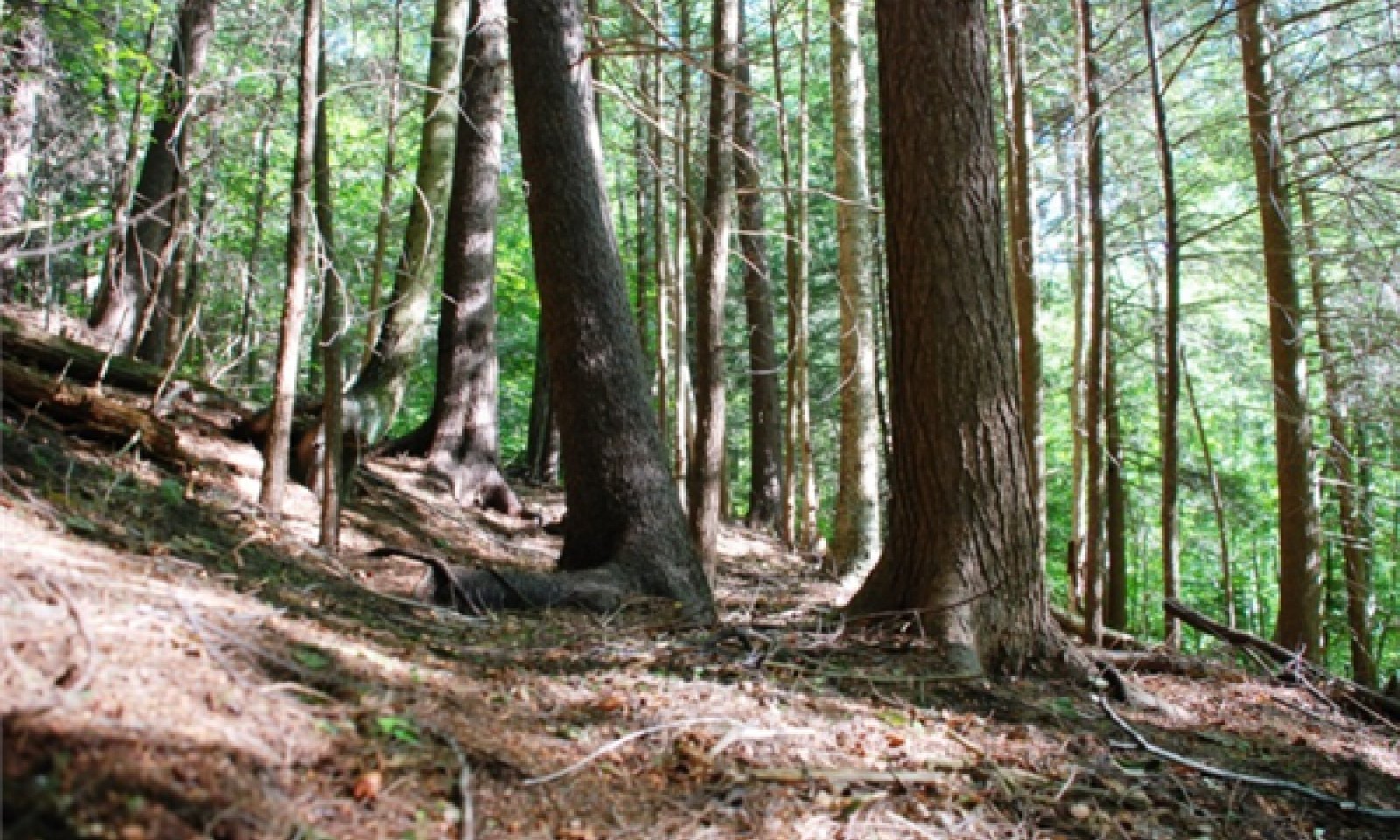

Natural Resources
Conservation Service
Ecological site F127XY001WV
Spodic Shale Upland Conifer Forest
Last updated: 9/27/2024
Accessed: 12/21/2025
General information
Approved. An approved ecological site description has undergone quality control and quality assurance review. It contains a working state and transition model, enough information to identify the ecological site, and full documentation for all ecosystem states contained in the state and transition model.
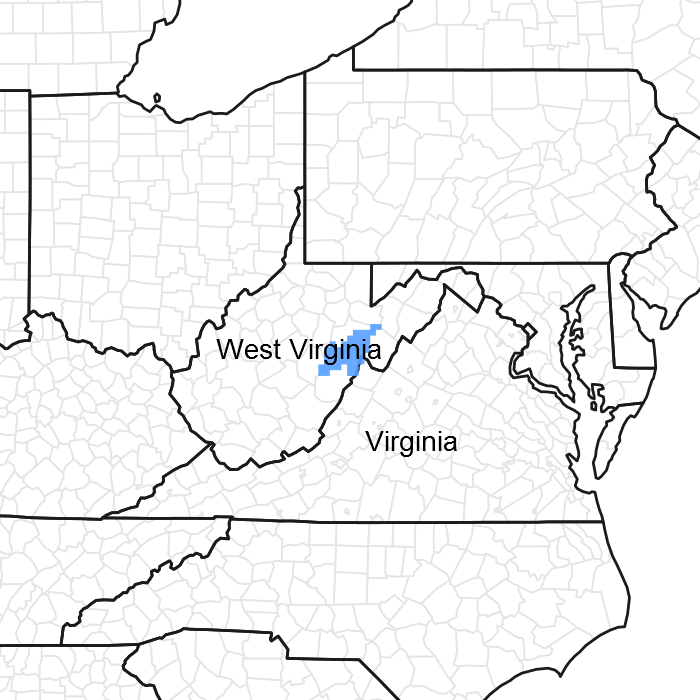
Figure 1. Mapped extent
Areas shown in blue indicate the maximum mapped extent of this ecological site. Other ecological sites likely occur within the highlighted areas. It is also possible for this ecological site to occur outside of highlighted areas if detailed soil survey has not been completed or recently updated.
MLRA notes
Major Land Resource Area (MLRA): 127X–Eastern Allegheny Plateau and Mountains
The Spodic Shale Upland Conifer Forest ecological site occupies the Allegheny Mountain Section of the Appalachian Highlands. The deeply dissected plateau in this area terminates in a high escarpment, the Allegheny Front, in the eastern part of the area. Steep slopes are dominant, but level to gently rolling plateau remnants occur in the northern part of the area. The area is dominantly forestland containing large blocks of state forest and game lands and national forests. Less than one-tenth of the major land resource area (MLRA) consists of urban areas.
Classification relationships
Central and Southern Appalachian Spruce-Fir CES202.028 (NatureServe 2015) http://explorer.natureserve.org/servlet/NatureServe?searchSystemUid=ELEMENT_GLOBAL.2.722677
Picea rubens - Tsuga canadensis - Fagus grandifolia / Dryopteris intermedia Forest CEGL006029 (NatureServe 2015) http://explorer.natureserve.org/servlet/NatureServe?searchCommunityUid=ELEMENT_GLOBAL.2.689733
SAF spruce-fir Society of American Foresters Cover Type Spruce-Fir (Eyre, 1980)
Ecological site concept
The overstory canopy of this ecological site is dominated red spruce and eastern hemlock. The climate is cool and moist with a frigid soil temperature regime and perudic soil moisture regime.This upland site exists on several geomorphic positions from the summit to the lower backslope and is dominantly found on north aspects; see Nauman et al (2015 a,b) for a model of Spodosol occurrence across the landscape. The geology of this site consists of Devonian inter-bedded sandstone and shale that is low pH and relatively base poor. Soils of this site show very strong evidence of podzolization and will classify as Spodosols. The nature of the thick organic O horizons (mor) favors conifer regeneration.
Associated sites
| F127XY002WV |
Spodic Intergrade Shale Upland Hardwood And Conifer Forest |
|---|
Table 1. Dominant plant species
| Tree |
(1) Picea rubens |
|---|---|
| Shrub |
Not specified |
| Herbaceous |
(1) Dryopteris intermedia |
Physiographic features
At the highest elevations in the State of West Virginia, this ecological site is generally composed of mountain ranges oriented in a northeast-southwest direction, with deep valleys intervening. The area of the site terminates in the eastern part in a high escarpment known as the Allegheny Front. Steep slopes are dominant but level to gently rolling plateau remnants are present. Water table at this site is deeper than 60 inches and the site both receives and generates runoff.
Table 2. Representative physiographic features
| Landforms |
(1)
Interfluve
(2) Mountain slope (3) Mountain |
|---|---|
| Flooding frequency | None |
| Ponding frequency | None |
| Elevation | 2,631 – 4,583 ft |
| Slope | 3 – 80% |
| Water table depth | 60 in |
| Aspect | N, E, W |
Climatic features
Mean annual air temperature in this ecological site is 46 degrees F. On many days in a normal winter there is no snow cover, but some years the ground is snow covered all winter. Cloudiness is more common than clear skies. About 81 days per year have clear skies, 196 days are cloudy, and the rest partly cloudy. In valleys, fog is prevalent in summer and fall; the high surface area of the conifer needles likely captures appreciable moisture from fog and may contribute significantly to the moist soil conditions. Rainfall is heaviest in summer and lowest in the fall. During the growing season, rainfall often exceeds potential evapo-transpiration. Long dry periods seldom occur. Westerly winds prevail at the higher elevations in all months of the year except August when southwesterly winds prevail. Damaging windstorms are rare.
Table 3. Representative climatic features
| Frost-free period (average) | 119 days |
|---|---|
| Freeze-free period (average) | 147 days |
| Precipitation total (average) | 51 in |
Figure 2. Monthly precipitation range
Figure 3. Monthly average minimum and maximum temperature
Figure 4. Annual precipitation pattern
Figure 5. Annual average temperature pattern
Influencing water features
This site is not directly influenced by water from wetland or stream.
Soil features
The soils of this site are dark grayish brown, moderately deep or deep silt loams and loams, and are represented by the Spodosol soil order. The main process in the formation of Spodosols is podzolization. Podzolization is a complex process in which organic material and soluble iron and aluminum are leached from the A and E horizons to the B horizon.
These soils are relatively infertile and conifers have evolved with Spodosols, making them well adapted to this acid and infertile soil type. Sandstone and shale fragments and rocks often occur in the profile or outcrop on the soil surface, but not to the extent that they impair the production of native vegetation. Plant-soil moisture relationships are good. In best condition , rills, gullies, wind scoured areas, pedestals, and soil compaction layers are not present on the site. The healthy sites with deep O horizons (e.g. folistic epipedons) contain a reservoir of soil nutrition, water storage, and provide surface protection.
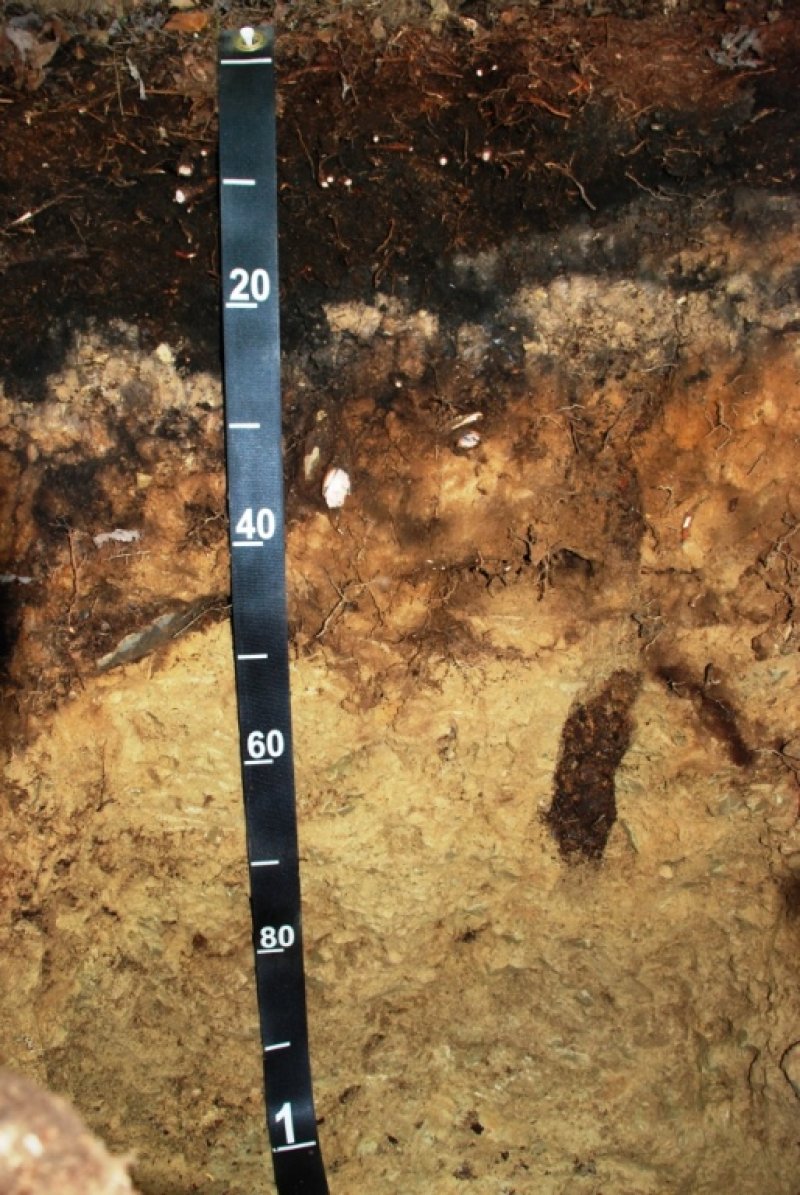
Figure 6. Wildell Soil
Table 4. Representative soil features
| Parent material |
(1)
Cryoturbate
–
acid shale
(2) Colluvium – sandstone and shale (3) Solifluction deposits – sandstone and siltstone |
|---|---|
| Surface texture |
(1) Channery silt loam (2) Very channery loam (3) Extremely channery loam |
| Family particle size |
(1) Loamy |
| Drainage class | Well drained |
| Permeability class | Moderate to moderately rapid |
| Soil depth | 20 – 60 in |
| Surface fragment cover <=3" | 5% |
| Surface fragment cover >3" | 3% |
| Available water capacity (0-40in) |
2 – 5.1 in |
| Calcium carbonate equivalent (0-40in) |
Not specified |
| Electrical conductivity (0-40in) |
Not specified |
| Sodium adsorption ratio (0-40in) |
Not specified |
| Soil reaction (1:1 water) (0-40in) |
3.3 – 4.8 |
| Subsurface fragment volume <=3" (Depth not specified) |
15 – 60% |
| Subsurface fragment volume >3" (Depth not specified) |
5 – 40% |
Ecological dynamics
The information contained in the state and transition model (STM) and the ecological site description was developed using archeological and historical data, professional experience, and scientific studies. The information presented is representative of a very complex set of plant communities. Not all scenarios or plants are included. Key indicator plants, animals and ecological processes are described to help guide land management decisions.
A red spruce mosaic forest historically covered 1,500,000 acres in West Virginia (Hopkins, 1899). Industrial logging and subsequent burns have reduced the coverage to roughly 60,000 acres (Adams and Stephenson, 1989; Pielke, 1981). This dramatic decrease of the red spruce-influenced forest has spurred the effort to quantify the former extent of red spruce for restoration purposes. Tools that can target restoration efforts include predictive models (Nowacki and Wendt, 2010) and witness tree databases (Thomas-Van Gundy et al., 2012 (a) (b)). An additional tool may be found through soil morphology, chemistry, and taxonomy. Soils harbor tell-tale signs of past red spruce occurrence through the presence of spodic materials. (Teets and Nowacki, 2012; Nauman et al., 2015 a,b).
Spodic materials can be formed by organic acids produced from decomposition or leaching of coniferous or ericaceous plant litter strongly reacting within the soil matrix. This soil chemical condition facilitates the transfer of humus and poorly crystalline aluminum and iron from surface (A and E horizon) to lower horizons (Bh/Bhs/Bs horizons). This process is called podsolization (Lundstrom et al., 2000). Spodosols are identified if the horizons made of spodic materials are well developed and the meet criteria of spodic horizon (Soil Survey Staff, 2010). Spodosols serve as definitive markers that conifers once existed on site (Teets and Nowacki, 2012; Nauman et al. 2015 a,b). Spodosols develop within cool, humid climates beneath conifers and thick snow packs (Stanley and Ciolkosz; Ciolkosz et al., 1989; Ugolini et al., 1990; Schaetzl and Isard, 1996).
The plant community composition of this site is relatively stable in the absence of human-caused disturbance. Red spruce and hemlock are long-lived and very shade-tolerant species. Natural disturbances in this community are characterized by windthrow of individual trees. Wildlife herbivory is relatively insignificant. Stand-replacing, lightning-ignited fires may affect large forest patch sizes but occur rarely, at 300 to 1,000-year intervals; large-scale wind events are likely at more frequent intervals of 100 to 200 years (Gorman, 2007) . Human-initiated disturbances have included agriculture (currently abandoned), logging, and slash fires.
Recent disturbances include accumulation of atmospheric pollutants and land conversion for resorts and second homes.
Historic accounts indicate that red spruce forests formed nearly pure stands of red spruce on the high, rocky ridges and plateaus, where nutrient-poor soils and abundant moisture favored spruce over hardwoods (Hopkins, 1899; Brooks, 1910; Korstian 1937; Clarkson, 1964 and references therein; Core, 1966 and references therein). Spruce-dominated old-growth forests of West Virginia and Virginia are rare, but include many individual dead spruce, making up 36 percent of all spruce stems and 44 percent of the total basal area (Adams and Stephenson, 1989). Annual mortality has been estimated at about 1 percent for spruce-fir forests of North Carolina and Tennessee (Busing and Wu, 1990), which is similar to the rate found in second-growth red spruce-northern hardwood forests of West Virginia at 1.4 percent (Rentch, et al. 2010). Diameter distributions of old growth stands show large numbers of small diameter trees mixed with scattered large trees that contain most of the basal area (Korstian, 1937; Oosting and Billings, 1951;Adams and Stephenson, 1989; Busing and Wu, 1990; Nicholas et al., 1992). Sizes of canopy gaps in spruce-dominated old-growth forests across northeastern North America have been found to have mean diameters of 24 to 126 meters squared (Seymour et al., 2002). For spruce-fir forests in Tennessee, major natural disturbance regimes include fire, debris avalanches, and wind with return intervals of more than 1,000 years for large gaps (greater than 200 meters squared from fires and debris avalanches) and 100 years for small gaps (less than 200 meters squared from wind events; White et al., 1985). Fire and debris avalanches are not likely to play as large of a role in the spruce-northern hardwood forests of West Virginia; although, the role of fire after exploitative logging of the 1900s is well documented (Clarkson; 1993). In northern Appalachian old-growth forests dominated by spruce and fir, no evidence of stand-replacing disturbances was found in the tree ring record (Fraver and White, 2005; Fraver et al., 2009). As these forests are dominated by a very shade-tolerant and long-lived species, we can infer that vertical and horizontal heterogeneity was high before the 1880s beginning of the industrial logging era.Sub-dominant trees in old-growth stands in West Virginia and Virginia were found to have a mean age of 157 years (Adams and Stephenson, 1991) and others have determined that in the southern Appalachians, red spruce required multiple release events to reach the canopy (Wu et al., 1999). Spruce-dominated old-growth in both Tennessee and New Hampshire were determined to have uneven-aged structure (Oosting and Billings, 1951).
A state-and-transition model for the site follows this narrative. Descriptions of each state, transition, plant community, and pathway follow the model. Experts base this model on available experimental research, field observations, professional consensus, and interpretations. It is likely to change as knowledge increases.
The reference state of this ecological site consists of one community phase; the reference state and community phase tends to remain stable for long periods of time. Fire is not an important factor due to the moist climate and soil conditions. Change within the community results primarily from single tree disturbance. The small openings from single tree disturbance allow the release of small suppressed spruce trees. Hardwoods such as yellow birch or other species germinate in these openings relatively quickly at locations mineral soil is exposed (i.e. tree throw tip-up pits and mounds). Lack of fire and the nature of conifer (red spruce) litter and root dynamics permit the accumulation of a deep layer of organic matter forest floor up to several feet thick. The forest floor helps maintain moist conditions, its chemical and physical characteristics favor the germination and survival of conifers over hardwoods.
Clearcutting of spruce and hemlock in the time period 1880-1920 not only removed the conifer overstory, but also destroyed much of the deep organic soil horizon and the conifer seed bank within it due to logging practices and low intensity fires common during the era.
Logs where skidded across the soil and slope on cable strung from the summit of the slope to the valley floor; occasionally, low intensity slash fires occurred at these sites. The new conditions exposed large areas of mineral soil that allowed hardwood trees, especially species such as American beech and black cherry which have heavy seed rain and seeds that spread rapidly over long distance due to transport by wind and birds, to invade these sites. Many areas still had remnant midstory spruce trees present and small understory spruce trees were abundant. Seeds of red spruce and hemlock typically travel a maximum of 200 meters. Red spruce and hemlock are able to re-establish sites canopy dominance if a few trees remain, but the process may take hundreds of years without restoration efforts such as timber harvesting, thinning, or applying herbicide to release suppressed understory conifers. Once a trajectory of conifer dominate overstory is set, the conifer will eventually shade many species out of existence and create edaphic conditions relatively adverse to hardwood regeneration. The site will be restored to the reference vegetative community, and over the period of hundreds of years will rebuild the thick forest floor through litter accumulation.
The logged states both share a common dominant (or co-dominant) tree – red maple and the occurrence of subdominant red spruce/eastern hemlock in the overstory or understory. Red maple has a large seed rain, is quick to establish, and is common throughout the range of this ecological site. The division between the two logged states is based upon the occurrence of co-dominant American beech or black cherry in the respective states. Sites with a history of soil erosion exposing extensive areas of mineral soil or light burning often have higher overstory canopy cover of black cherry; sites with relatively less disturbance have higher overstory canopy cover occurrence of beech.
In areas that experienced intense logging slash fires caused by railroad sparks and negligent fire management, the site was sent on an entirely new vegetation trajectory and often entirely different soil was formed through depozolization (see WV127XY002). In areas that maintained the Spodosol soil, the thick forest floor and conifers were burned and large areas of mineral soil were exposed. During the Great Depression until World War II, the Civilian Conservation Corps (CCC) and the U.S. Forest Service (USFS) re-vegetated many of these burned locations and abandoned marginal farmland with conifer plantations.
These areas were planted to prevent soil erosion and to provide timber products and wildlife habitat. The current condition of these areas is a plantation of mature even-aged Norway spruce and occasional plantations of red or white pine timber, or both. These species are not endemic to the ecological site area and have created an artificial ecological condition.
Distinguishing soil characteristics beyond the strong evidence of podzolization and the formation of Spodosol is the occurrence of thick organic forest floors. These folistic epipedon likely take hundreds of years of litter accrual to form once the overstory canopy is conifer dominant. Disturbed states often lack thick forest floors and they are unlikely to re-establish old growth characteristics (e.g. thick Oa horizons) within current human lifetime scale.(See Nauman et al. (2015 a,b) for a discussion of “deep” forest floor accretion within human lifetime scale.) The thick forest floor harbors soil micro and macro species that facilitate unique ecological (see Bonan and Shugart, 1989) and soil chemical processes (see discussion of podzolization above).
Plant communities will differ across the MLRA because of the naturally occurring variability in weather, soils, and aspect. The Reference Plant Community is not necessarily the management goal. The biological processes on this site are complex. Therefore, representative values are presented in a land management context. The species lists are representative and are not botanical descriptions of all species occurring, or potentially occurring, on this site. They are not intended to cover every situation or the full range of conditions, species, and responses for the site
State and transition model
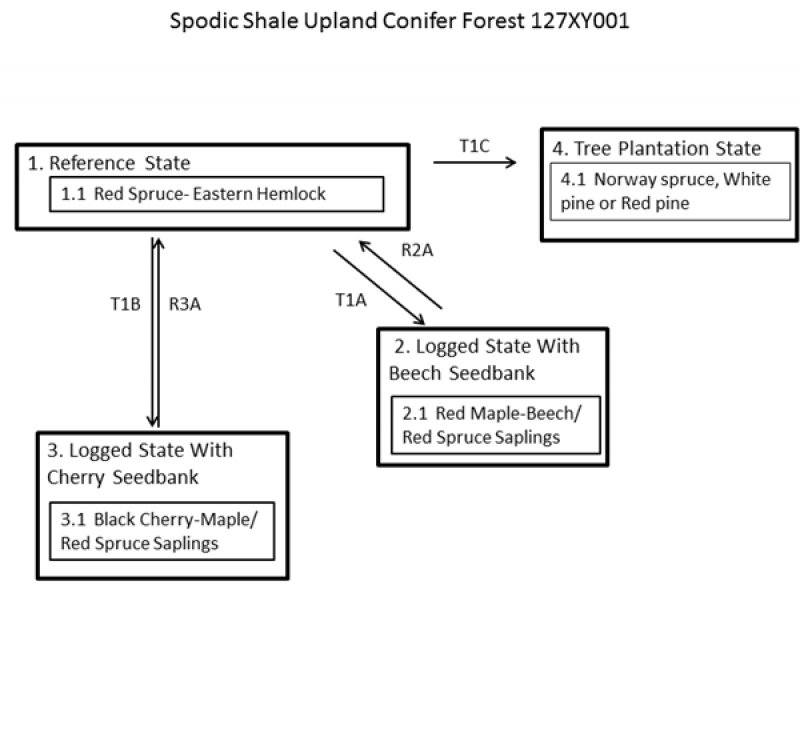
Figure 7. Spodic Shale Upland Conifer Forest 127XY001
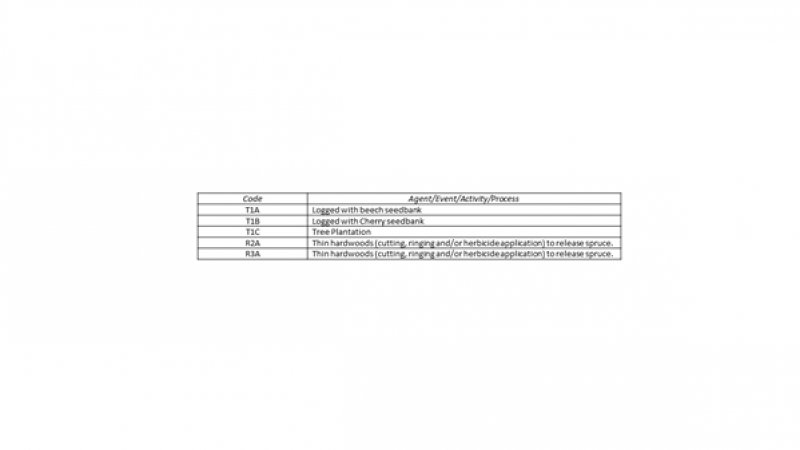
Figure 8. State and Transition Diagram Legend
More interactive model formats are also available.
View Interactive Models
More interactive model formats are also available.
View Interactive Models
Click on state and transition labels to scroll to the respective text
State 1 submodel, plant communities
State 2 submodel, plant communities
State 3 submodel, plant communities
State 4 submodel, plant communities
State 1
Reference State
This state represents the natural range of variability that dominates the dynamics of this site. The canopy typically has strong dominance by Picea rubens (red spruce), with Tsuga canadensis (eastern hemlock) next in importance. Shrub cover is sparse or absent; herbs are sparse or absent. The plant community is maintained by an absence of fire and major disturbance. Pre-European settlement disturbance consisted of single tree disturbance associated with wind, snow and or/ice damage.
Community 1.1
Picea rubens-Tsuga canadensis

Figure 9. Spodic Shale Upland Conifer Forest
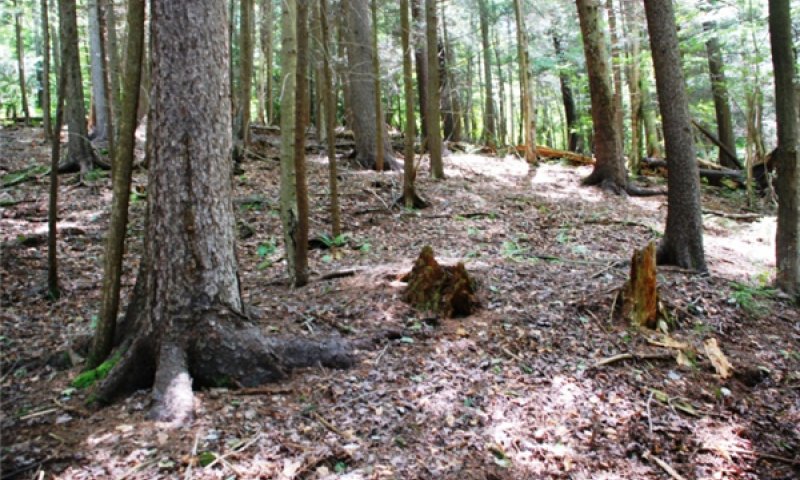
Figure 10. Spodic Shale Upland Conifer Forest structure
This image represents the reference community for the site. The description is based on historical descriptions, site index data, professional consensus of experienced ecologists, and analysis of field work. Old growth forests of this type are very rare. Indicators of this site are greater than 30-50 percent conifer canopy cover (red spruce and eastern hemlock). Spodosol soil order and organic matter accumulation and occurrence of folistic epipedons. Feedbacks that maintain the site are red spruce acidifies the soil, forms spodic horizons, and causes development of thick organic horizons. Thick conifer needle mor creates unfavorable conditions for hardwood regeneration Feedbacks: red spruce acidifies the soil, forms spodic horizons, and causes development of thick organic horizons. Thick conifer needle mor creates unfavorable conditions for hardwood regeneration.
Forest overstory. The upper canopy averages 85% cover and is strongly dominated by Picea rubens (red spruce) and Tsuga canadensis (eastern hemlock), with lower cover of Betula alleghaniensis var. alleghaniensis (yellow birch), Acer rubrum (red maple) and other trees that occasionally occur with low cover in the canopy include Acer pensylvanicum (striped maple) and Amelanchier laevis (Allegheny serviceberry). The subcanopy very similar in dominance and composition to the canopy.
Forest understory. The understory is strongly dominated by saplings of the regenerating canopy species, especially Picea rubens (red spruce). The fern/herbaceous/non-vascular stratum is dominated by moss, Lycopodium spp., and wood ferns.
Table 5. Soil surface cover
| Tree basal cover | 2-4% |
|---|---|
| Shrub/vine/liana basal cover | 0.0-0.1% |
| Grass/grasslike basal cover | 0.0-0.1% |
| Forb basal cover | 0.1-0.5% |
| Non-vascular plants | 0.1-0.5% |
| Biological crusts | 0% |
| Litter | 75-85% |
| Surface fragments >0.25" and <=3" | 0.1-3.0% |
| Surface fragments >3" | 0.1-3.0% |
| Bedrock | 0.0-0.1% |
| Water | 0% |
| Bare ground | 0% |
Table 6. Woody ground cover
| Downed wood, fine-small (<0.40" diameter; 1-hour fuels) | 3-7% |
|---|---|
| Downed wood, fine-medium (0.40-0.99" diameter; 10-hour fuels) | 2-4% |
| Downed wood, fine-large (1.00-2.99" diameter; 100-hour fuels) | 3-5% |
| Downed wood, coarse-small (3.00-8.99" diameter; 1,000-hour fuels) | 2-3% |
| Downed wood, coarse-large (>9.00" diameter; 10,000-hour fuels) | 3-5% |
| Tree snags** (hard***) | – |
| Tree snags** (soft***) | – |
| Tree snag count** (hard***) | 1-20 per acre |
| Tree snag count** (hard***) | 1-10 per acre |
* Decomposition Classes: N - no or little integration with the soil surface; I - partial to nearly full integration with the soil surface.
** >10.16cm diameter at 1.3716m above ground and >1.8288m height--if less diameter OR height use applicable down wood type; for pinyon and juniper, use 0.3048m above ground.
*** Hard - tree is dead with most or all of bark intact; Soft - most of bark has sloughed off.
Table 7. Canopy structure (% cover)
| Height Above Ground (ft) | Tree | Shrub/Vine | Grass/ Grasslike |
Forb |
|---|---|---|---|---|
| <0.5 | 0-1% | 0-1% | 0-1% | 0-1% |
| >0.5 <= 1 | 0-1% | 0-1% | 0-1% | 0-1% |
| >1 <= 2 | 0-1% | 0-1% | 0-1% | 0-1% |
| >2 <= 4.5 | 0-1% | 0-1% | – | 0-1% |
| >4.5 <= 13 | 1-10% | 0-1% | – | – |
| >13 <= 40 | 1-25% | – | – | – |
| >40 <= 80 | 65-75% | – | – | – |
| >80 <= 120 | 80-95% | – | – | – |
| >120 | 0-20% | – | – | – |
State 2
Logged State With Beech Seedbank
This state occurs after logging, with an absence of fire or with the occurencce of very light fire. Remaining beech trees contribute seed rain to the site and/or beech seeds remain in the soil seedbank. Beech bark disease (BBD), an non-native invasive disease from Europe, has altered the plant community. This disease, a complex affecting American beech, includes both insect and fungal components. The disease passes through three phases: the initial scale front phase, the second killing front phase, and the final aftermath forest phase. During the initial phase, the exotic scale insect disperses through the forest, causing scale-induced alterations to patches of bark. The killing front phase begins 1 to 19 years after the arrival of the scale. Throughout this phase, the scale-modified bark is killed and colonized by species of Neonectria, rendering the dead tissues vulnerable to additional decaying fungi. The resulting beech snap and mortality levels may reach 50 percent in 5 years. The final aftermath forest phase results in an ecological accommodation to the disease, resulting in either a change in species composition or the death of re-emergent beech. The genetically identical stump sprouts and root suckers (beech brush), which appear following the initial BBD deaths die in a second wave of BBD. A majority of these sites have red spruce regeneration. A minority of these sites have an absence of red spruce regeneration.
Community 2.1
Red Maple-Beech
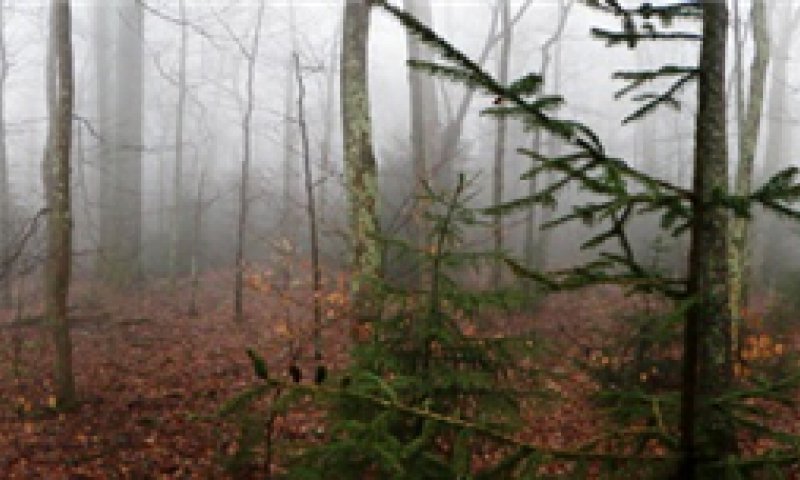
Figure 11. Red Maple-Beech
This community was created by logging followed by human-induced , low intensity fire. Indicators of this site are less than 30 percent red spruce overstory, with hardwoods co-dominating. Feedbacks maintaining this site are red spruce is suppressed or absent in the understory. Hardwood leaf litter inhibits conifer regeneration.
State 3
Logged State With Cherry Seedbank
This state occurs after logging and with an absence of fire or occurrence of very light fire. Residual cherry trees remain to contribute seed rain and/or seed remains in soil seedbank. The majority of this phase contains spruce regeneration; a minority does not.
Community 3.1
Black Cherry-Maple
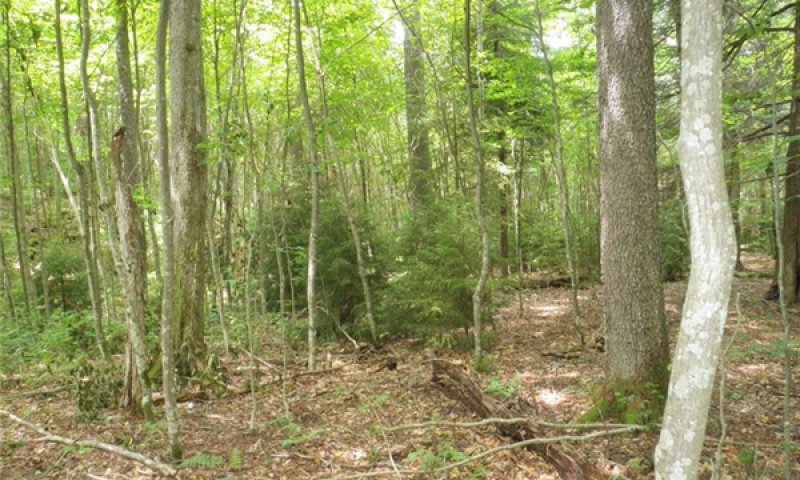
Figure 12. Black Cherry-Maple
This community was created by logging or human-induced , low intensity fire. Indicators of this site are less than 30 percent red spruce overstory canopy cover, with hardwoods co-dominating. Feedbacks maintaining this site are red spruce is suppressed in the understory or absent in the understory. Hardwood leaf litter may inhibit conifer regeneration.
State 4
Tree Plantation State
Restoration requires variable density thinning (cutting, ringing or herbicide application) to create structural diversity and release spruce. Planting red spruce when seedlings are absent will establish red spruce at the site
Community 4.1
Norway Spruce, White Pine or Red Pine
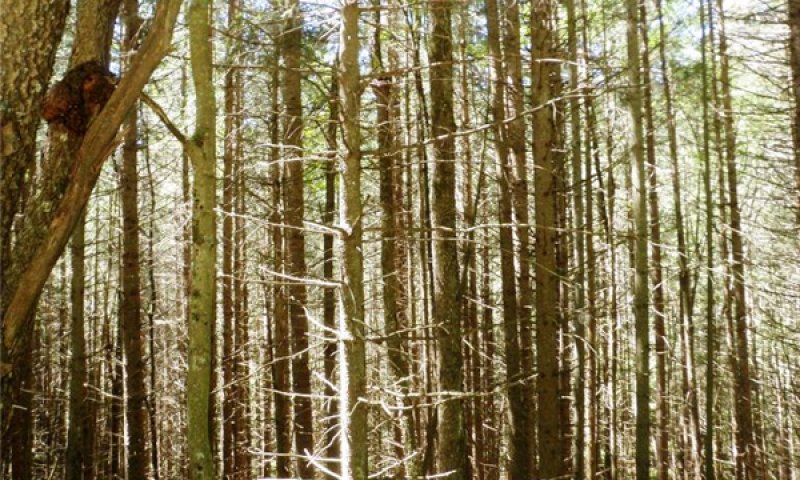
Figure 13. Norway Spruce Plantation
This phase is a plantation planted by the Civilian Conservation Corps and the United States Forest Service during the 1930s and 1940s. The areas were planted to provide timber products and wildlife habitat.
Transition T1A
State 1 to 2
This transition occurs via logging with the absence of fire or the occurrence of light fire, leaving the spruce and beech seed sources intact.
Transition T1B
State 1 to 3
This transition occurs via logging with the absence of fire or the occurrence of light fire, leaving the spruce and cherry seed sources intact.
Transition T1C
State 1 to 4
This transition occurs via logging, intense fire, and commercial tree planting. Some sites reflect planting of abandoned marginal farmland.
Restoration pathway R2A
State 2 to 1
Restoration requires the thinnning hardwoods (cutting, ringing, or herbicide application) to release red spruce. Planting red spruce if red spruce absent will establish spruce in the understory.
Conservation practices
| Tree/Shrub Site Preparation | |
|---|---|
| Tree/Shrub Establishment | |
| Forest Stand Improvement |
Restoration pathway R3A
State 3 to 1
Restoration of the site requires thinning of hardwoods (cutting, ringing, or herbicide application) to release red spruce.
Conservation practices
| Forest Stand Improvement |
|---|
Restoration pathway R4A
State 4 to 1
Variable density thinning (cutting, ringing and/or herbicide application) to create structural diversity and release spruce. Planting spruce when seedlings are absent.
Additional community tables
Table 8. Community 1.1 forest overstory composition
| Common name | Symbol | Scientific name | Nativity | Height (ft) | Canopy cover (%) | Diameter (in) | Basal area (square ft/acre) |
|---|---|---|---|---|---|---|---|
|
Tree
|
|||||||
| red spruce | PIRU | Picea rubens | Native | 80–110 | 30–75 | 14–17 | – |
| red spruce | PIRU | Picea rubens | Native | 65–100 | 50–75 | – | – |
| eastern hemlock | TSCA | Tsuga canadensis | Native | 35–110 | 10–50 | 14–18 | – |
| red maple | ACRU | Acer rubrum | Native | 60–115 | 10–30 | 7–10 | – |
| eastern hemlock | TSCA | Tsuga canadensis | Native | 15–75 | 0–20 | – | – |
| mountain magnolia | MAFR | Magnolia fraseri | Native | 45–60 | 0–10 | – | – |
| cucumber tree | MAAC | Magnolia acuminata | Native | 50–65 | 0–10 | – | – |
| yellow birch | BEAL2 | Betula alleghaniensis | Native | 50–75 | 0–10 | 7–9 | – |
| black cherry | PRSE2 | Prunus serotina | Native | 70–100 | 0–10 | 12–16 | – |
| sweet birch | BELE | Betula lenta | Native | 50–75 | 0–10 | – | – |
| eastern hemlock | TSCA | Tsuga canadensis | Native | 5–20 | 0–5 | – | – |
Table 9. Community 1.1 forest understory composition
| Common name | Symbol | Scientific name | Nativity | Height (ft) | Canopy cover (%) | |
|---|---|---|---|---|---|---|
|
Forb/Herb
|
||||||
| common yellow oxalis | OXST | Oxalis stricta | Native | 0.1–0.4 | 0–0.1 | |
| Indian cucumber | MEDEO | Medeola | Native | 0.1–0.5 | 0–0.1 | |
| partridgeberry | MIRE | Mitchella repens | Native | 0.1–0.2 | 0–0.1 | |
| trillium | TRILL | Trillium | Native | 0.1–0.5 | 0–0.1 | |
|
Fern/fern ally
|
||||||
| running clubmoss | LYCL | Lycopodium clavatum | Native | 0.1–0.5 | 0–1 | |
| intermediate woodfern | DRIN5 | Dryopteris intermedia | Native | 0.4–1.5 | 0–0.1 | |
|
Shrub/Subshrub
|
||||||
| Allegheny serviceberry | AMLA | Amelanchier laevis | Native | 6–13 | 0–1 | |
| Allegheny serviceberry | AMLA | Amelanchier laevis | Native | 0.1–1 | 0–0.1 | |
|
Tree
|
||||||
| red spruce | PIRU | Picea rubens | Native | 1.5–6.5 | 0–10 | |
| red spruce | PIRU | Picea rubens | Native | 6.5–13 | 0.1–10 | |
| striped maple | ACPE | Acer pensylvanicum | Native | 6–13 | 0–5 | |
| yellow birch | BEAL2 | Betula alleghaniensis | Native | 0.4–1.5 | 0–1 | |
| red spruce | PIRU | Picea rubens | Native | 0.4–1.5 | 0–1 | |
| sweet birch | BELE | Betula lenta | Native | 0.4–1.5 | 0–1 | |
| sweet birch | BELE | Betula lenta | Native | 1.5–3.3 | 0–1 | |
| red maple | ACRU | Acer rubrum | Native | 0.1–0.5 | 0–1 | |
|
Nonvascular
|
||||||
| BATR5 | Bazzania trilobata | Native | 0.1–0.4 | 0.1–20 | ||
| splendid feather moss | HYSP70 | Hylocomium splendens | Native | 0.1–0.4 | 0–10 | |
Interpretations
Animal community
This ecological site includes three forested phases: Conifer dominated canopy, hardwood dominated canopy, and a conifer dominated canopy tree plantation. Conifer species on non-plantation sites include red spruce and hemlock; on plantations Norway spruce, red pine and occasionally white pine. The hardwood dominated canopy includes beech, black cherry, red maple, cucumber magnolia, and yellow birch with red spruce and hemlock a minor component of the canopy.
This ecological site and related phases provides critical habitat and ecosystem functions for numerous wildlife species. Some wildlife species that show a preference for this type of vegetation includes, but not limited to, northern goshawk, pine siskin, swainson’s thrush, olive-sided flycatcher, red crossbill, West Virginia northern flying squirrel, snowshoe hare, spruce knob, threetooth snail, black bear, grouse, bobcat, fisher, and whitetail deer.
Using the Natural Resources Conservation Service (NRCS) plans and programs to establish or maintain forest habitat will ensure that landowners can protect, conserve, and enhance their natural resources including the many species of wildlife that depend on these sites.
Recreational uses
A majority of land that this ecological site description represents is owned by the federal government as part of the United States Forest Service Monongahela National Forest. Many trails exists throughout the ecological site. Hiking, biking, horseback riding, hunting, and fishing are very popular recreation opportunities. Birdwatching and wildflower (plant) identification are potential recreational pursuits. Steeper trails, e.g. greater than 15 percent, may be susceptible to soil erosion.
Wood products
This land is generally used for habitat conservation. Occasionally commercial logging occurs. Valuable tree species (i.e. black cherry) exist on disturbed states, and red spruce is valued for musical instruments.
Other information
Habitat conservation and carbon sequestration (see Nauman et al. 2015 a,b) are important attributes of this ecological site.
Supporting information
Inventory data references
Tier I Data- Low intensity data collection including field reconnaissance; verification of soil maps; ocular estimates; plant identifications; taking photos; recording GPS coordinates; making field notes; developing ecological site concepts in field; etc.
Tier II Data- Medium intensity data including additional qualitative and quantitative data collection; plant identifications; additional soils verification; taking photos; recording GPS coordinates; making field notes; testing ecological site concepts and site keys in field for ecological sites ranges of variability; etc.
Tier III Data-High intensity data collection including additional quantitative data at type locations to support finalized ecological site concepts and populate ESDs; plant identifications; intensive soils verification, as needed; taking photos; recording GPS coordinates; making field notes; verifying ESD state-and-transition model and indentify plants in the field to establish full range of variability for ecological site; etc. This includes relevé data and West Virginia Department of Natural Resources Natural Heritage plots.
Type locality
| Location 1: Pocahontas County, WV | |
|---|---|
| Latitude | 38° 42′ 52″ |
| Longitude | 79° 45′ 7″ |
| General legal description | Pocahontas County, West Virginia; travelling along FS Road 35, about 2.9 kilometers east of the junction of FS Road 44 and FS Road 35 (site of the former town of Wildell), then about 90 meters SW of Snorting Lick Run. USGS Wildell quadrangle |
Other references
Adams, H.S., and S.L. Stephenson. 1989. Old-growth red spruce communities in the mid- Appalachians. Vegetatio 85: 45-56.
Adams, H.S., and S.L. Stephenson. 1991. High elevation coniferous forests in Virginia. Virginia Journal of Science 42(4): 391-399.
Brooks, A.B. 1910. WV Geological Survey, Volume 5: Forestry and Wood Industries. Acme Publishing Co, Morgantown, WV.
Busing, R.T., and X. Wu. 1990. Site-specific mortality, growth, and structure of a Great Smokey Mountains red spruce population. Canadian Journal of Forest Research 20: 206- 210.
Ciolkosz, E.J., W.J. Waltman, T.W. Simpson, and R.R. Dobos. 1989. Distribution and genesis of soils of the northeastern United States. Geomorphology 2:285-302.
Clarkson, R. B. 1964. Tumult on the Mountains: Lumbering in West Virginia – 1770-1920. McClain Printing Co., Parsons, WV. 410 pp.
Clarkson, R.B. 1993. Destruction of the upland forest by lumbering and fire. In: Eds. Stephenson, S.L. Upland forests of West Virginia. McClain Printing Co., Parsons, WV. Core, E.L. 1966. Vegetation of West Virginia. McClain Printing Co., Parsons, WV.
Eyre, F.H. (Editor) 1980. Forest Cover Types of the United States and Canada. Society of American Foresters
Fraver, S., and A.S. White. 2005. Disturbance dynamics of old-growth Picea rubens forests of northern Maine. Journal of Vegetation Science 16: 597-610.
Fraver, S., A.S. White, and R.S. Seymour. 2009. Natural disturbance in an old-growth landscape of northern Maine, USA. Journal of Ecology 97: 289-298.
Hopkins, A.D. 1891. Preliminary report: black spruce. West Virginia Agricultural Experiment Station, Bulletin No. 17: 93-102.
Hopkins, A.D. 1899. Report on investigations to determine the cause of unhealthy conditions of the spruce and pine from 1880-1893. West Virginia Agricultural Experiment Station, Bulletin 56: 197-461.
Korstian, C.F. 1937. Perpetuation of spruce on cut-over and burned lands in the higher southern Appalachian Mountains. Ecological Monographs 7(1): 125-167.
Lundstrom, U.S., N. van Breeman, and D. Bain. 2000. The podzolization process: A review. Geoderma 94:91-107.
Oosting, H.J., and W.D. Billings. 1951. A comparison of virgin spruce-fir forest in the northern and southern Appalachian system. Ecology 32(1): 84-103.
NatureServe. 2015. NatureServe Explorer: An online encyclopedia of life [web application]. Version 7.1. NatureServe, Arlington, Virginia. Available http://explorer.natureserve.org. (Accessed: December 16, 2015 ).
Nauman, T. W., J. A. Thompson, S. J. Teets, T. A. Dilliplane, J. W. Bell, S. J. Connolly, H. J. Liebermann, and K. M. Yoast. 2015a. Ghosts of the forest: Mapping pedomemory to guide forest restoration. Geoderma 247:51-64.
Nauman, T. W., J. A. Thompson, J. Teets, T. Dilliplane, J. W. Bell, S. J. Connolly, H. J. Liebermann, and K. Yoast. 2015b. Pedoecological Modeling to Guide Forest Restoration using Ecological Site Descriptions. Soil Science Society of America Journal.
Pielke, R.A. 1981. The distribution of spruce in west-central Virginia before lumbering. Castanea 46: 201-216.
Rentch, J.S., T.M. Schuler, G.J. Nowacki, N.R. Beane, and W.M. Ford. 2010. Canopy gap dynamics of second-growth red spruce -northern hardwood stands in West Virginia. Forest Ecology and Management 260: 1921-1929.
Schaetzl, R.J. and S.A. Isard. 1996. Regional-scale relationships between climate and strength of podsolization in the Great Lakes Region, North America. Catena 28:47-69. Seymour, R.S., A.S. White, A.S., and P.G. deMaynadier. 2002. Natural disturbance regimes in northeastern North America - evaluating silvicultural systems using natural scales and frequencies. Forest Ecology and Management 155: 357-367.
Soil Survey Staff. 2010. Keys to Soil Taxonomy, 11th ed. USDA-Natural Resources Conservation Service, Washington, DC.
Stanley, S.R. and E.J. Ciolkosz. 1981. Classification and genesis of Spodosols in the Central Appalachians. Soil Sci. Soc. Amer. J. 45:912-917.
Thomas-Van Gundy, M., and M. Strager. 2012. European settlement-era vegetation of the Monongahela national forest, West Virginia. USDA Forest Service, Northern Research Station, General Technical Report NRS-101.
Teets, J. G. Nowacki (2012). Conservation and Restoration of America’s Great Outdoors: Soil Science Adds Additional Restoration Tools. http://www.nrcs.usda.gov/wps/portal/nrcs/detail/wv/newsroom/factsheets/?cid=nrcs144p2_074439
Thomas-Van Gundy, M., M. Strager, and J. Rentch. 2012. Site characteristics of red spruce witness tree locations in the uplands of West Virginia, USA. Journal of the Torrey Botanical Society 139(4): 391-405.
Ugolini, F.C., R. Dahlgren, and K. Vogt. 1990. The genesis of Spodosols and the role of vegetation in the Cascade Range of Washington, U.S.A. P. 370-380 in J.M. Kimble and
R.D. Yeck (eds.), Proc. 5th Int. Soil Correlation Mtg. Characterization, Classification, and Utilization of Spodosols. USDA-SCS, Lincoln, NE.
White, P.S., M.D. MacKenzie, and R.T. Busing. 1985. Natural disturbance and gap phase dynamics in southern Appalachian spruce-fir forests. Canadian Journal of Forest Research 15 : 223-240.
White, P.S., and J.L. Walker. 1997. Approximating nature’s variation: Selecting and using reference information in restoration ecology. Restoration Ecology 5(4): 338-349.
Wu, X., F. McCormick, and R.T. Busing. 1999. Growth pattern of Picea rubens prior to canopy recruitment. Plant Ecology 140: 245-253.
Contributors
Jason Teets
Approval
Greg Schmidt, 9/27/2024
Rangeland health reference sheet
Interpreting Indicators of Rangeland Health is a qualitative assessment protocol used to determine ecosystem condition based on benchmark characteristics described in the Reference Sheet. A suite of 17 (or more) indicators are typically considered in an assessment. The ecological site(s) representative of an assessment location must be known prior to applying the protocol and must be verified based on soils and climate. Current plant community cannot be used to identify the ecological site.
| Author(s)/participant(s) | |
|---|---|
| Contact for lead author | |
| Date | 09/27/2024 |
| Approved by | Greg Schmidt |
| Approval date | |
| Composition (Indicators 10 and 12) based on | Annual Production |
Indicators
-
Number and extent of rills:
-
Presence of water flow patterns:
-
Number and height of erosional pedestals or terracettes:
-
Bare ground from Ecological Site Description or other studies (rock, litter, lichen, moss, plant canopy are not bare ground):
-
Number of gullies and erosion associated with gullies:
-
Extent of wind scoured, blowouts and/or depositional areas:
-
Amount of litter movement (describe size and distance expected to travel):
-
Soil surface (top few mm) resistance to erosion (stability values are averages - most sites will show a range of values):
-
Soil surface structure and SOM content (include type of structure and A-horizon color and thickness):
-
Effect of community phase composition (relative proportion of different functional groups) and spatial distribution on infiltration and runoff:
-
Presence and thickness of compaction layer (usually none; describe soil profile features which may be mistaken for compaction on this site):
-
Functional/Structural Groups (list in order of descending dominance by above-ground annual-production or live foliar cover using symbols: >>, >, = to indicate much greater than, greater than, and equal to):
Dominant:
Sub-dominant:
Other:
Additional:
-
Amount of plant mortality and decadence (include which functional groups are expected to show mortality or decadence):
-
Average percent litter cover (%) and depth ( in):
-
Expected annual annual-production (this is TOTAL above-ground annual-production, not just forage annual-production):
-
Potential invasive (including noxious) species (native and non-native). List species which BOTH characterize degraded states and have the potential to become a dominant or co-dominant species on the ecological site if their future establishment and growth is not actively controlled by management interventions. Species that become dominant for only one to several years (e.g., short-term response to drought or wildfire) are not invasive plants. Note that unlike other indicators, we are describing what is NOT expected in the reference state for the ecological site:
-
Perennial plant reproductive capability:
Print Options
Sections
Font
Other
The Ecosystem Dynamics Interpretive Tool is an information system framework developed by the USDA-ARS Jornada Experimental Range, USDA Natural Resources Conservation Service, and New Mexico State University.
Click on box and path labels to scroll to the respective text.